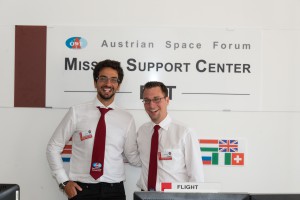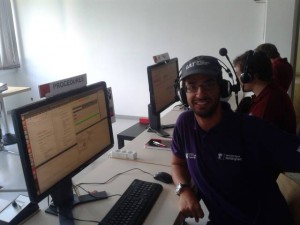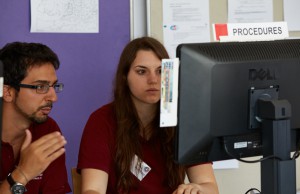
September 4, 2015, by Emma Lowry
On a mission to prepare humans for Mars
In August 2015, Simone Paternostro – an Early Stage Researcher on the Marie Curie Project ‘Innovate‘ based in the Institute for Aerospace Technology (IAT) at The University of Nottingham – took part in a two-week Mars simulation mission on a rock glacier in the Kaunertaler Glacier in Austria.
Simone – a positioning and navigation specialist in the IAT who is studying for a PhD with Nottingham Geospatial Institute – was part of Flight Control Team within the Mission Support Center (MSC). The Mars simulation was led by the Austrian Space Forum (OeWF) where a small field crew at the Mars analog site was directed by the Mission Support Center in Innsbruck, Austria. The crew’s task was to carry out experiments to pave the way for future human missions to Mars.
The international expedition, called the AMADEE-15 mission, was the highest ever simulation of a human Mars mission carried out anywhere in the world.
Rock glaciers at the Kaunertal Alps served as the Mars base camp. The purpose of the mission was to explore the possibility of future human expeditions to the ice regions on Mars in the fields of engineering, planetary surface operations, astrobiology and geosciences. By using the conditions of the glacier in Austria (and the height) – the team was able to replicate what life on the barren planet may be like.
The University is really proud that one of its own was part of this ground-breaking mission. Here, Simone talks about his role in the mission.
It was a great honour to take part in a mission of this magnitude, and an experience I won’t ever forget. During the mission I had the opportunity to cover three different positions – each giving me a great insight into how a real-life expedition of this kind would work.
As the Flight Director Assistant (FD-A), I acted as the ‘first officer’ to the Flight Director (FLIGHT). In principle, the Flight Director can delegate any task to the FD-A and all other team members interact with the FD-A as well as FLIGHT. However, the final responsibility and decision-making authority lies with FLIGHT. The FD-A is also responsible for updating the news feed of the team’s website as part of its outreach activities.
Next I was the science console and contact manager (CONTACTS) – the ‘gateway” to external teams. This role was the single-point-of-contact for remote science support teams and PIs (Principle Investigators – the scientists that provided the experiments), who were not present at the base. Usually, during ongoing experiments on “Mars”, the CONTACTS supervised the connectivity and ensured a high level of situational awareness among the external parties.
Simone on duty on the Procedure Console
In the role of Procedure, I maintained the compilation of the standard operating procedures, as well as experiment procedures, and ensured that the field crew as well as the MSC personnel had, at any time, access to the most recent edition. During the simulation, I observed if the sequence of events is according to any given procedures.
Everything started when on December 2014, by chance, I came across the advert of the Austrian Space Forum for Analog Astronauts selections. I found the “open position” very interesting and I sent off the application.
I went through all the selection process that was divided in three different steps:
- Phase A: OeWF reviewed about a hundred CVs and selected 30 candidates for the second phase
- Phase B: These candidates were subjected to a series of different tests – from psychological to motivational; general knowledge and more
- Phase C: 15 candidates were shortlisted for the last phase and the five Analog Astronauts positions available. Final tests included technical and practical tests as well as medical and fitness
Unfortunately I wasn’t selected as an Analog Astronaut, however the organisation did go on to invite unsuccessful shortlisted candidates to join the team as active members of the Mission Support Center. I jumped at the chance, knowing it was a great opportunity to get involved in this far-sighted project and meet new people.
Checking the experimental procedure for the planned daily activities together with another team member
Photo credit: Paul Santek and Claudia Stix
I was not disappointed. This unique experience helped me to understand the complexity of a manned mission in space, not only from a technological and technical point of view, but also from an organisational perspective. The missions are supported by several teams, each with its own tasks and duties. Every role is essential and important at the same level, no one team is above the other; it’s like a clock mechanism, if all the components work correctly everything proceeds smoothly.

Simone – with Flight Director, Clemens Plank – on his first day as Flight Director Assistant
Photo credit: Christian Lüthen
Featured image:
The Flight Control Team pose to promote the “I am a Mars Pioneer” contest proposed by OeWF to promote Mars Manned missions
Photo credit: Vanessa Weingartner
No comments yet, fill out a comment to be the first



Leave a Reply